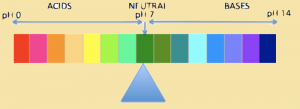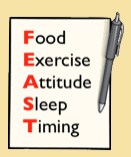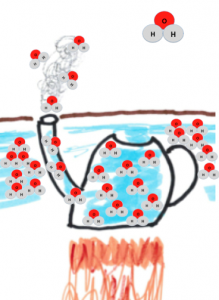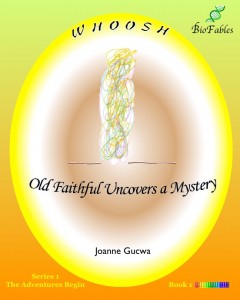Additional Whoosh Resources
Are you a homeschooler or a parent who helps in your child’s (childrens’) educational progress? Congratulations! And welcome to Whoosh Knowledge Gateways page.
Here you will discover the wealth of practical knowledge contained within the pages of Whoosh. This free resource will help you to locate and reinforce those lessons woven throughout Whoosh which you’d like to help your young learners grasp more fully. (For a brief introduction to Whoosh, please visit the Whoosh home page)
An example of BioFables’ 5-tier knowledge category structure:
-
- 1. Core Disciplines: Sciences, Humanities, Values/Behaviors
- 2. Knowledge Gateways (Color-coded examples: Earth/Space Science, History, Spirit)
- 3. Discovery Paths (Example: Geology, a Discovery Path of Earth/Space Science)
- 4. Discovery Path Branches (Example: Geysers, a Discovery Path Branch of Geology)
- 5. Knowledge Nuggets: Titles of specific mini- or pop-up lessons (Example: Geyser ingredients). You and your young readers likely will be most interested in Tier 5, Knowledge Nuggets. The 5-tier structure will be helpful in tracing lessons back through the earlier tiers to their learning origins.
- 4. Discovery Path Branches (Example: Geysers, a Discovery Path Branch of Geology)
- 3. Discovery Paths (Example: Geology, a Discovery Path of Earth/Space Science)
- 2. Knowledge Gateways (Color-coded examples: Earth/Space Science, History, Spirit)
- 1. Core Disciplines: Sciences, Humanities, Values/Behaviors
NOTE: Please be aware that category names in tiers 2-5 are unique to each book, with using words that children would recognize (e.g. plants), rather than formal terminology (e.g. botany). The following lists and tables, of course, incorporate categories that specifically appear in Whoosh. They do not represent a complete list of categories within Sciences, Humanities and Values/Behaviors core disciplines.
Site Tips offers more insights into how you can use the tables, lists and other resources of this website to help you to help your children uncover the secrets of about 100 lessons scattered throughout each BioFables book.
In this page you’ll find four sets of tables and lists; these are tools for helping you help your children derive the greatest benefit from reading Whoosh:
-
-
- Whoosh, by chapter: Sciences, Humanities, Values/Behaviors
- Sciences content
- Humanities content
- Values/Behaviors content
-
Whoosh, by Chapter
TABLE 1, Whoosh is arranged chapter-by-chapter. It’s a good way to get a mental picture of the entire book, especially the chapter descriptions and links to additional resources (child-friendly links are in orange). This table incorporates the three Core Disciplines, their Knowledge Gateways and Discovery Paths (Tiers 1-3).
The rows in the left column of the table, highlighted in light green, show the Chapter number and the chapter’s pages; following the highlighted row is a quick chapter overview and occasional resource links to relevant sites for further investigation (links to child-friendly sites are in orange).
The right column rows, highlighted in light green, show the chapter’s title. The chapter’s color-coded Knowledge Gateways, with their associated Discovery Paths, appear beneath each chapter title.
TABLE 1. Whoosh by Chapter: Sciences, Humanities and Values/Behaviors
| CHAPTER: Page Numbers |
CHAPTER TITLES |
| Brief Chapter Description; Resource Links | Knowledge Gateways (in color); Discovery Paths |
| Helpful Hints | |
| Chapter 1: Pages 1-4 |
Old Faithful = “Old Faceful?” |
| It felt warm and wonderful when “Old Faceful” steam surrounded Melody, but even a few stray droplets stung and left red spots her twin brother’s bare skin. |
|
| Chapter 2: Pages 4-8 |
Old Faithful Behaves |
| Mom’s graceful yoga “dance” keeps time with the erupting geyser, with Mom and geyser both earning the applause of other visitors. |
|
| Chapter 3: Pages 9-12 |
Bubbling Along the Boardwalk |
| A nature trail like no other…bubbles and burps, hissing and splashing… unexpected colors that belonged to fields of wild flowers, not water and mud. |
|
| Chapter 4: Pages 13-18 |
Nature: A Closer Look |
| Dr. Ethyl reveals some of the mystery of what’s going on just under the boardwalk as the Maloney family walks the planks a second time.
Geysers (Wikipedia) |
|
| Chapter 5: Pages 19-23 |
All Steamed Up |
| Water and steam: same H2O. BUT…how about that huge difference in distance between water and steam molecules? |
|
| Chapter 6: Page 24-28 |
How Hot Is Hot? |
| Water, boiling water, steam, superheated water: geysers have all these forms of H2O, but that’s not all. Dr. Ethyl starts with Mallory’s diagram of an underground teapot to explain how geysers work. |
|
| Chapter 7: Pages 29-34 |
Living Thermometers |
| Could anything live in these brightly colored, steaming water? Would you believe microbes, their colors revealing how hot they prefer their baths? |
|
| Chapter 8: Pages 35-39 |
pH? What’s That? |
| It’s not only heat that these extremophile microbes love, it’s also the extreme acidity or alkalinity (the other side of the acidity scale). |
|
| Chapter 9: Pages 40-46 |
Telling Grandpa Mike about Yellowstone |
| Reviewing some of what they learned at Yellowstone with Grandpa Mike, the twins accidentally reveal Melody’s extremophile-like experience. |
|
| Chapter 10: Pages 47-48 |
Next Adventure |
| The twins look forward to “meeting” lots of animals, Mom’s cousin who runs a family farm and driving a special experimental car to Southern Illinois. |
|
The Core Disciplines in Whoosh LIST 1 are presented with their Knowledge Gateways and Discovery Paths (Tiers 1-3) in side-by-side columns. We’ve grouped each of the Knowledge Gateways and their Discovery Paths into Basic (foundational knowledge), Hybrid (relevant both to Basic and Applied Discovery Paths), and Applied (using basic or hybrid principles for practical, real-world purposes).
LIST 1. Whoosh Overview: Sciences, Humanities and Values/Behaviors
| SCIENCES | HUMANITIES | VALUES/BEHAVIORS |
|
BASIC
HYBRID
APPLIED
|
BASIC
HYBRID
APPLIED
|
BASIC
HYBRID
APPLIED
|
The next three sets of lists and tables compile the Sciences, Humanities and Values/Behaviors content for the entire Whoosh book. Bulleted lists of Knowledge Gateways, with their associated Discovery Paths, offer a quick glance at category tiers 1-3 appearing in Whoosh. Their associated tables incorporate all 5 category tiers, including brief definitions of the Knowledge Gateways and instances of the specific Knowledge Nuggets (lessons) within each Core Discipline.
Whoosh Sciences Core Discipline

Whoosh List 2 is an at-a-glance bulleted list, offering a quick look at the Sciences Knowledge Gateways in bold, followed by their Discovery Paths that appear in Whoosh.
Whoosh LIST 2. Sciences Knowledge Gateways and Discovery Paths
-
-
- Biology: Microbes/Bacteria; Plants
- Chemistry: Molecules; Elements; Forms; Functions
- Physics: Heat, Temperature, Pressure
- Earth, Space Science: Geology; Geography
- Math: Measurements; Comparisons
- Technology: Physics (Optics)
-
Whoosh TABLE 2 includes the major Sciences KNOWLEDGE GATEWAYS (light green background) occurring in all the chapters of Whoosh.
LEFT COLUMN
KNOWLEDGE GATEWAYS appear in alphabetical order. The rows below each Knowledge Gateway name one or more of its associated Discovery Paths (indented); Discovery Path Branches, where they occur, are further indented below the Discovery Path. These categories represent increasingly-specific subjects.
RIGHT COLUMN
Brief definitions of each Sciences Knowledge Gateway help to recognize subjects related to the Gateway. Definitions of Discovery Paths that are split into more-detailed groups in the left column are identified by a yellow background. Knowledge Nuggets offer the most specific information or lessons.
Whoosh TABLE 2. Sciences Content
| KNOWLEDGE GATEWAYS |
Brief Definitions: Knowledge Gateways/Discovery Paths |
| Discovery Paths/Path Branches |
Discovery Path Branches; Knowledge Nuggets |
| BIOLOGY | Life and living things |
| Microbes/Bacteria | Living thermometers: Extremophile colors show hot spring temperature {Ch. 7, pp. 29-34} |
| Plants | Converting daylight to energy through photosynthesis {Ch 7, p. 34} |
| CHEMISTRY | Substances, their structure, behavior, interactions |
| Molecules | What is that awful smell? Hydrogen sulfide (H2S) {Ch. 4, p. 15} |
| Elements; Forms | Same water elements (H2O), different states: liquid, gas (steam) [solid (ice)] {Ch. 5, p. 20} |
| Functions | pH: Chemical condition of a solution, from 0 to 14 (H2O = 7, neutral) {Ch. 8, pp. 35-37; Ch. 9, p. 41} |
| PHYSICS | Properties and nature of matter and energy |
| Heat, Temperature, Pressure | What do guysers and pressure cookers have in common? Superheated steam! {Ch. 6, p. 25} |
| EARTH, SPACE SCIENCE | Related to planet Earth and beyond |
| Geology | Earth’s physical structure, substance, history, processes |
| Geysers | What are geyser ingredients? H2O, molten rock (magma), cracks in solid rock {Ch. 6, p. 26-27} |
| Hot springs | Don’t put your brushes into these paint pots, plan a fun fight in these mud pots, or try to enjoy a steam bath in a fumerole! {Ch. 4, p. 16} |
| Volcanoes, calderas | Volcano: A mountain or hill with a vent that allows hot lava, rock and gases to erupt from the earth’s crust; after the eruption, a collapse causes a depression or caldera {Ch. 4, p. 17} |
| Geography | Continents, countries, oceans/other waters, and their features |
| Wyoming, Chicago | Yellowstone is about 1,400 miles west/northwest of Chicago by road and about 1190 by air {Helpful Hints} |
| MATH | Numbers, quantities and analysis |
| Measurements | Size, length and amount, either actual or estimated {Ch. 9, pp. 42-43} |
| Comparisons | Rules of thumb help to relate big and little things {Ch. 9, p. 44} |
| TECHNOLOGY | Tools (products) and techniques using science |
| Microscopes (Physics: Optics) | You can see things with a microscope that are otherwise invisible {Ch. 2, p. 6; Ch. 6, p. 22; Ch. 7, pp. 32-33} |
Whoosh Humanities Core Discipline

Whoosh LIST 3 is an at-a-glance bulleted list. It offers a quick look at the Humanities Knowledge Gateways in bold, followed by their Discovery Paths that appear in Whoosh.
Whoosh LIST 3. Humanities Knowledge Gateways and Discovery Paths
-
-
- Language: Sounds and Spelling; Word Derivations; Classic Literature
- History: Locations
- Health: FEAST
- Arts: Writing; Play on Words; Singing; Rhythmic Movements; Ideas
- Work, Careers: Musician; Biologist; Explorer; Tai Chi Instructor; Wellness Guide; Chemist; Microbiologist
-
Whoosh TABLE 3 includes the major Humanities Knowledge Gateways (light green background) occurring in all the chapters of Whoosh.
The left column shows each Knowledge Gateway and one or more associated Discovery Paths. Discovery Path Branches, where they occur, appear indented below the major Discovery Path. These branches (and sometimes sub-branches) are divisions of the major Discovery Path; they represent increasingly-specific fields.
The right column offers brief definitions of each Humanities Knowledge Gateway. Following each Knowledge Gateway are Knowledge Nuggets (mini- or pop-up lessons). These lessons correspond to the Discovery Path and any Discovery Path Branches that appear directly across in the the left column.
Whoosh TABLE 3. Humanities Content
| KNOWLEDGE GATEWAYS |
Brief Definitions: Knowledge Gateways |
| Discovery Paths |
Discovery Path Branches; Knowledge Nuggets |
| LANGUAGE | Means of communication |
| Sounds and Spelling | Guy Sir or geyser? Are there Gal Ma’ams? (Guys and, um Gals?) {Ch. 3, p. 10} |
| Word Derivations | Celestine Pool looks celestial blue {Ch. 4, p. 14} |
| Cyanobacter microbes are named from Greek color greenish-blue {Ch. 7, p. 33} | |
| Geothermal: Geo (earth) thermal (heat); Greek “earth heat” {Ch. 4, p. 17} | |
| Caldera (circular indentation in the ground): from Spanish cauldron or large circular pot {Ch. 4, p. 18} |
|
| Extremeophile microbes love temperature extremes {Ch. 7, p. 31} | |
| Classic Literature | “Fire burn and cauldron bubble” (Macbeth: Shakespeare) {Ch. 4, p. 18 |
| King Arthur, Sir Lancelot, Knights of the Round Table {Ch. 6, p. 26} | |
| HISTORY | Information about the past |
| Locations | Yellowstone: World’s first National Park, established in 1872 {Ch. 4, p. 14} |
| HEALTH | Level of well-being |
| FEAST | Mom’s philosophy: Food Exercise Attitude Sleep Timing {Ch. 4, p. 14} |
| ARTS | Creative skills and their expression |
| Writing | Writing new words to familiar tunes {Ch. 6, p. 28} |
| Play on Words | Dr. Ethyl A. Shun names a small geyser Sir Splashalot {Ch. 6, p. 26} |
| Singing | What do “Twinkle, twinkle little star” and “Baa, Baa Black Sheep” have in common? {Ch. 6, p. 28} |
| Rhythmic Movements | Onlookers applaud Mom’s Tai Chi duet with Old Faithful {Ch. 2, p. 7} |
| Ideas | A color-coded thermometer to identify extremophile bacteria presence {Ch. 7, p. 34} |
| WORK/CAREERS/ROLE MODELS |
Productive activity to earn an income or give back to society |
| Musician | 7-year-old Melody’s interest is suggested by her name {Ch. 8, p. 38} |
| Biologist | Melody’s science interest is sparked by colorful microbes {Ch. 8, p. 38} |
| Explorer | Melody’s twin brother Mallory just happens to be interested in his famous namesake’s career {Ch. 8, p. 38} |
| Tai Chi Instructor | Mom’s Tai Chi movements are more than simply exercise {Ch. 2, pp. 6-7} |
| Wellness Guide | Mom incorporates FEAST into her wellness advice {Ch. 4, p. 14} |
| Chemist | Dad’s knowledge of chemical principals comes in handy {Ch. 4, p. 15; Ch. 8, pp. 36-37} |
| Microbiologist | Dr. Shun studies extremophiles at Yellowstone {Ch. 2, pp. 8, 11, 45} |
Whoosh Values/Behaviors Core Discipline

Whoosh LIST 4 is an at-a-glance bulleted list. It offers a quick look at the Values/Behaviors Knowledge Gateways in bold, followed by their Discovery Paths that appear in Whoosh.
Whoosh LIST 4. Values/Behaviors Discovery Paths and Knowledge Branches
-
-
- Morals/Ethics: Honesty/Truth
- Emotions: Concern for Others; Sense of Humor; Disappointment
- Mind: Sense of Wonder; Word Games; Visualization; Intuition; Inferring Meaninng of Words
- Body: Balance/Stability; Natural Movement
- Learning/Knowledge/Skills:Exploration; Sharing Knowledge; Aquiring Knowledge
- People: Parental Responsibility; Sibling Teasing; Concern for Others; Generosity; Respect, Gratitude, Hospitality; Keeping in Touch
- Planet: Research
-
Whoosh TABLE 4 includes the major Values/Behaviors Knowledge Gateways (light green background) occurring in all the chapters of Whoosh.
The left column shows each Knowledge Gateway and one or more associated Discovery Paths. Discovery Path Branches, where they occur, appear indented below the major Discovery Path. These branches (and sometimes sub-branches) are divisions of the major Discovery Path; they represent increasingly-specific fields.
The right column offers brief definitions of each Values/Behaviors Knowledge Gateway. Following each Knowledge Gateway are Knowledge Nuggets (mini- or pop-up lessons). These lessons correspond to the Discovery Path and any Discovery Path Branches that appear directly across in the the left column.
Whoosh TABLE 4. Values/Behaviors Content
| KNOWLEDGE GATEWAYS |
KNOWLEDGE GATEWAYS: BRIEF DEFINITIONS |
| Discovery Paths. Discovery Path Branches | Knowledge Nuggets: Mini and Pop-up Lessons |
| Morals/Ethics |
Internal character, beliefs |
| Honesty/Truth | A long sleeved shirt hides the twins’ disobedience {Ch 1, pp 4-5} |
| What were you up to? “Nothing, just looking around” {Ch 1, p. 4} | |
| Melody reluctantly promises Dad she won’t try to feel how hot the waters are beneath the boardwalk {Ch. 3, p. 10} | |
| The twins feel guilty when Dr. Shun refers to the dangers of superheated water from geysers {Ch. 6, p. 25} | |
| Emotions | Feelings, sentiment, intuition |
| Concern for Others | Mallory is relieved that his sister isn’t scalded {Ch. 1, p. 3} |
| Sense of Humor | Dad refers to his singing voice as “good for cooling soup” {Ch. 6, p. 28} |
| Mom and Dad tease each other about redecorating their house with vivid colors that extremophiles demonstrate {Ch. 7, p. 29} | |
| “Yum” – Mallory is reminded of colorful fruits and veggies {Ch. 7, p. 30} | |
| Disappointment | Melody learns her idea of an extremophile thermometer is impractical {Ch. 7, p.34} |
| Mind | Rational, theoretical, analytical thinking |
| Sense of Wonder | Melody is awed that ordinary people can actually visit a spectacular place such as Yellowstone {Ch. 3, p. 9} |
| Word Games | The Maloneys and Dr. Shun play “20 Questions” {Ch. 3, pp. 11-12; Ch. 4, p. 17} |
| Visualization | Mallory draws a geyser as a giant submersed teapot {Ch. 4, p. 13; Ch. 6, p. 26; Ch. 9, p. 42, 44} |
| Mallory sees the Octopus shape in Octopus Spring {Ch. 7, p. 30} | |
| Intuition | Grandpa suspects Melody actually could be an extremophile {Ch. 9, p. 45} |
| Inferring Meaning of Words | Celestine Pool reminds Mom of celestial which refers to the skies, which are blue (just like Celestine Pool) {Ch. 4, p. 14} |
| Body | Health, bodily strengh and movement |
| Balance/Stability | Mallory worries he’ll lose his balance on the boardwalk or on the stepping stones at Dr. Shun’s cabin {Ch. 3, p. 9; Ch. 6, p. 24} |
| Natural Movement | Mom’s Tai Chi form mimics Old Faithful’s eruption sequence {Ch. 2, pp. 6-7} |
| Learning/Knowledge/Skills |
Pursuit and acquisition of understanding, wisdom, capabilities |
| Exploration | After exploring online, the family wants to make the best of their time while they’re at Yellowstone {Ch. 2, p. 7} |
| Sharing Knowledge | Dr. Shun helps the Maloney family better understand the unusual sights, sounds and smells they first encountered {Ch. 3, p. 11; Ch. 4-8} |
| The twins are anxious to tell Grandpa all they learned {Ch. 9} | |
| Acquiring Knowledge | The Maloneys eagerly absorb Dr. Shun’s lessons {Ch. 3, p. 11; Ch. 4-8} |
| Melody thinks “complicated” makes things interesting {Ch. 8, p. 37} | |
| People | Regard for, and relationships with, humankind |
| Parental Responsibility | Dad warns the twins about getting to close to a geyser {Ch. 1, p. 1} |
| Mom makes sure everyone eats a hearty breakfast {Ch. 2, p. 5} | |
| Dad warns Melody not to test the hot springs’ temperatures {Ch. 3, pp. 9-10} | |
| Sibling Teasing | Melody makes light of her brother’s concern for her {Ch. 1, p.3} |
| Concern for Others | Melody worries about her brother’s scald marks on his arms {Ch. 1, pp. 3-4} |
| Generosity | Thanks to Grandpa’s gift, the Maloneys are exploring Yellowstone National Park {Ch. 2, p. 7; Ch. 9, p. 45} |
| Respect | The twins address the scientist as “Dr. Shun” (even though the adults use each others’ first names) {Ch. 3, p. 11} |
| The twins don’t want to contradict Dr. Shun about only bacteria can be extremophiles and people can’t {Ch. 8, pp. 38-39} | |
| Hospitality | Dr. Shun invites the Maloneys to her hidden cabin for lunch and more learning {Ch. 4, p. 15} |
| Keeping in Touch | The Maloneys plan to send a followup email to Dr. Shun {Ch. 9, p. 46} |
| Planet | Earth’s natural environment: living organisms, surface, water, subsurface, atmosphere |
| Research | Dr. Shun shares her knowledge of bacteria, laws of chemistry and physics, and geology with the Maloneys {Ch. 3, p. 11; Ch. 4-8} |
For an overview of Whoosh, please visit the Whoosh home page. If you are ready to buy Whoosh, please click on the icon. It will take you to Barnes and Nobles’ Whoosh page.


